People 'n' Issues
Rage against the screen
Younger users are done with traditional TV, as they embrace streaming, says LESLIE ADAMS of Reach Africa.
The data is in, and it’s official: things are not looking good for South African television.
The latest MAPS data overview from the Market Research Foundation shows a massive decline in television viewership over the past two years: In Q1 2021, 72% of respondents claimed to have tuned into a TV channel in the past week, while in Q3 2023, only 54% said they had. And this is only expected to grow, with loadshedding anticipated to make its comeback as the country enters its post-election era and settles into winter.
In parallel to this, streaming is growing – and FAST. According to the Broadcast Research Council of SA, almost a third of TV viewing now happens online. An estimated eight million South Africans now have access to a plethora of streaming services., with YouTube taking centre stage
“While YouTube doesn’t serve premium broadcast content, it does have scale,” says Leslie Adams, sales director at streaming experts Reach Africa.
“Google’s advertising resources indicate that in YouTube has around 25.1-million users, which is largely thanks to its advertising video on demand (AVOD) model, where viewers can watch for free in exchange for having their viewing interrupted now and then by a few ads.”
And who is driving the shift to streaming? According to the MAPS data, it’s the 12-27-year-old age group, defined by MAPS as Gen Z (42%), followed by those aged 28 to 43 (41%), with the 60-78 group only making up around 4%. As expected, Gen Z’s viewing happens mainly on mobile. (Bizarrely, MAPS still uses these arbitrary age groupings, with the oldest being labelled Baby Boomers, despite South Africa never having experienced this phenomenon).
This evolution away from traditional TV makes sense, says Adams, when you consider that more so than any previous generation, Gen Z’s life is lived on demand.
“If they want something to eat, they can order a takeaway via Uber Eats with a simple tap. If they want to listen to music, Spotify will not only find them the exact song they’re after but will also curate playlists for them based on their demonstrated preferences.”
And when they want to watch something, there are now over 30 streaming services available locally, which they can toggle between to their heart’s content on any device of their choosing, earning them the title of “Netfickle”.
To understand the mindset of younger users, one needs to consider the context, says Adams. “This generation grew up during the most optimistic time in SA’s history; they were born after apartheid, the much-loved Nelson Mandela was president, and SA had just won the Rugby World Cup. It was SA’s golden years; a time of joy, consolidation and celebration.”
But then they discovered hardship.
“They saw a recession, State Capture, a pandemic, several wars, the cost of living crisis, and a host of other challenges. They know real depression. They’ve seen how easy it is to lose everything you’ve worked hard for.
“And so they prioritise happiness and experiences over stability. They might not prioritise owning property; they may prefer renting and rather spending their money on something that brings them status and joy now. They want experiences over luxury items; fulfilment over stability; they believe there are multiple ways – not only one way.”
Adams says that it is this growing up with life on demand that has steered them firmly away from the ‘appointment viewing’ offered by linear TV. “Gone are the times when the household would plan the day around watching a show that airs at a certain time – Gen Z has never really known this reality, having grown up in a world powered by the internet.
“They won’t wait till 7pm to watch the news or catch the morning papers – they will scan a news site immediately when they want to know something. And those that are doing well understand this – most of Disney’s new releases now happen on its Disney+ app at the same time that they appear on cinema, for example.”
Adams says that ‘free’ is driving this shift.
“With the rise of AVOD and hybrid streaming services such as Viu – which has a huge youth viewing contingent and features SA’s biggest shows such as Skeem Saam and Uzalo – paid TV has naturally become the biggest victim of streaming.
“Free TV is still doing well, with SABC 1 being the country’s most-watched channel, followed by E-TV, SABC 2 and SABC 3. However, what we’re now seeing more and more – especially among younger SA viewers – is ‘platform stacking’. They might glance at the TV when it is on in the household and be pulled into a show, but their viewing is mainly happening online via streaming platforms such as Viu, at their convenience.
“And don’t believe the myth that expensive data is a barrier to entry; Gen Z has found a way around this, and best believe they are getting their content.
“There is no doubt that the streaming landscape is the space to watch right now, and it will be interesting to see how it evolves over the coming months.”



















